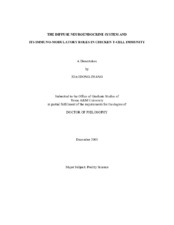| dc.description.abstract | Neuroendocrine cell populations were systematically studied and characterized in the thymus, an avian primary immune organ. The expression of the specific mRNAs for both Chromogranin A (CgA) and Carboxypeptidase E (CpE) in the thymus was first verified by RT-PCR. Additional evidence using immunofluorescent dual labeling, has demonstrated for the first time the co-existence of CgA and CpE in identical neuroendocrine cells at the protein level in a vetebrate primary lymphoid organ. These CpE- and CgA-positive cells were primarily found in the transition zone between the cortex and the medulla of the thymic lobules, an area known to contain numerous arterioles and to be heavily innervated by the autonomic nervous system, suggesting that these cell population can potentially receive input from each other, from the autonomous nervous system, from the circulation, or all of the above. (Neuro)endocrine messenger molecules produced by the thymic microenvironment, such as somatostatin (SST), seem to play a potentially important immunomodulatory role with regard to cell proliferation, differentiation, and migration, as well as cytokine production. The results showed that both SST and its receptor, SSTR2, are expressed locally within chicken thymus. The in vitro study showed that SST significantly inhibits IL-2 and concanavalin A (ConA) induced proliferation of thymocytes. In comparison with controls (medium containing IL-2 and ConA but without SST), addition of SST at 10-9 M and 10-6 M resulted in a nearly 20% decrease in proliferation (P < 0.01). The effects of somatostatin (SST) on the immune system, the role of SST on the gene expression of cytokines (IL-1, TGF, INF), chemokine receptors (CXCR4) as well as MHC-I components was assessed by real-time PCR. The question as to exactly which stimuli trigger the release of mediators such as somatostatin remains for future study. In addition, a complete inventory of all substances stored in the thymic LDCV and their effects on the developing T-cells when released in the microenvironment of the thymus are also questions that warrant further investigation. | en |


